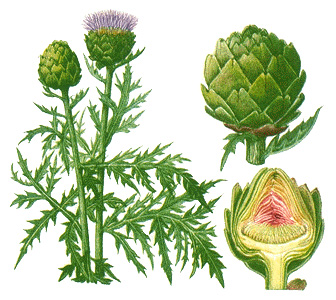Artichoke is a large, thistlelike plant that produces edible flower buds. The scales and hearts (centers) of the buds are eaten as vegetables. Artichokes provide a number of vitamins and minerals. Artichokes are sometimes called globe artichokes. They originated in the Mediterranean region. In the United States, artichokes are grown commercially chiefly in California.

Artichoke plants stand 3 to 5 feet (0.9 to 1.5 meters) tall and may spread over an area 5 to 6 feet (1.5 to 1.8 meters) in diameter. In the spring, the crown (top of the root) sprouts stems surrounded by large, coarse leaves. Round or oblong buds develop at the tips of the stems and branches. The buds are immature flowers and may range from light to dark green and may have a red or purple tint. Buds weigh up to 1 pound (0.45 kilogram).
Artichokes thrive in frost-free climates with cool, foggy summers. Commercial growers usually plant artichoke seedlings, though the plants can grow from seeds. Artichoke plants may live more than 15 years. However, commercial growers usually replant their fields every three or four years to ensure strong, active growth. The buds are harvested before they mature—otherwise, they become inedible. Some harvesting takes place in late summer and into the fall, but most of it is carried out the following spring.
The plant called Jerusalem artichoke is related to the sunflower. It is not a true artichoke. See Jerusalem artichoke .
